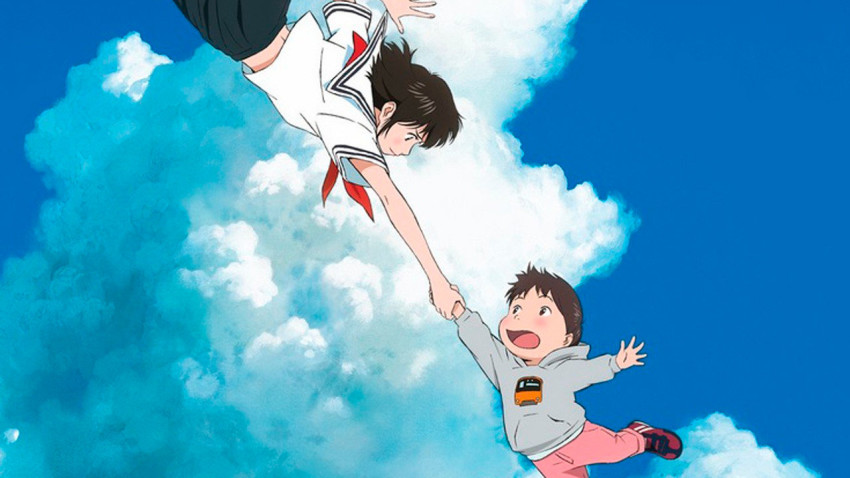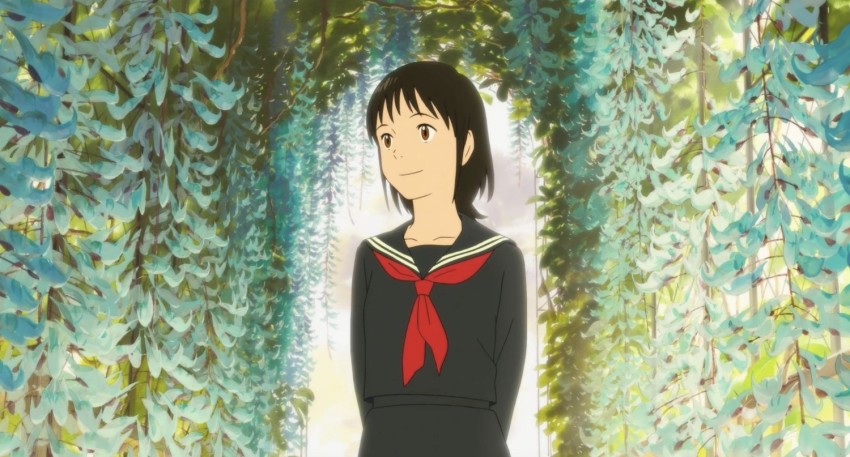Mirai at the Oscars
January 22, 2019 · 0 comments
by Andrew Osmond.
 And so, it’s finally happened. For the first time ever, an anime feature film which isn’t made by Studio Ghibli has become an official Oscar nominee – namely Mamoru Hosoda’s toddler’s-view fantasy Mirai. As far as most people are concerned, this is the director’s fifth film, following Girl Who Leapt Through Time, Summer Wars, Wolf Children and Boy and the Beast. Pedants can point to the auteur’s prior work in the Digimon and One Piece universes, though arguably Hosoda’s Digimons only became a “feature” when they were shredded and squashed together in the terrible US Digimon – The Movie. That has a princely 25% on Rotten Tomatoes, by the way.
And so, it’s finally happened. For the first time ever, an anime feature film which isn’t made by Studio Ghibli has become an official Oscar nominee – namely Mamoru Hosoda’s toddler’s-view fantasy Mirai. As far as most people are concerned, this is the director’s fifth film, following Girl Who Leapt Through Time, Summer Wars, Wolf Children and Boy and the Beast. Pedants can point to the auteur’s prior work in the Digimon and One Piece universes, though arguably Hosoda’s Digimons only became a “feature” when they were shredded and squashed together in the terrible US Digimon – The Movie. That has a princely 25% on Rotten Tomatoes, by the way.
Mirai has been far more lauded for its invention and boldness. Hosoda himself agreed that it was his most “different” kind of film when I interviewed him last year. Depicting the world as seen by a four year-old boy, Mirai has the kind of freeform logic that reminded me of some of the old children’s fantasies by writers like E. Nesbit, as our hero encounters his baby sister as a teen, his dog as a swaggering prince-in-exile, and other family members. I think Mirai has moments comparable to some Ghibli films, particularly the child scenes in Takahata’s Only Yesterday, though it also reminded me of Terry Gilliam – Hosoda acknowledged both Gilliam and Takahata as favourites.
Still, I was ambivalent about Mirai, finding it easier to admire and respect than to embrace. In my review for Sight and Sound, I wrote about its “conspicuously offbeat” pacing and rhythm, and complained that its “episodic story coheres without building.” Notably Mirai’s trailers were especially misleading, suggesting a more conventional adventure like Girl Who Leapt Through Time. Despite this, the film’s Japanese box-office was less than half of either Wolf Children or Boy and the Beast. Indeed, Mirai earned less in Japan than the same year’s Doraemon and Detective Conan animated spin-offs, not to mention a little franchise film called Dragon Ball Super: Broly (see the rankings here).
Still, Mirai is a fine film, a demonstration of Hosoda’s artistic growth, and a wholly deserving Oscar nominee. For the record, this is the sixth anime feature to be Oscar-nominated, following Spirited Away’s historic win back in 2002 and Howl, Wind Rises, Kaguya and Marnie all runner-ups. (The Ghibli-produced French film The Red Turtle was Oscar-nominated in 2016, but it’s not an anime.) If I was being catty, I could point out that Howl has a Hosoda connection, being the film that he was thrown off, but that’s another story.
 I don’t think Mirai has any substantial chance of winning, but it would be churlish to complain about the competition. Two years ago, I fretted that a change in voting rules could lead to Hollywood cartoons dominating ever after… but there’s no sign of that happening. Yes, many fans complained when the lame CG films Ferdinand and The Boss Baby were nominated last year. But so were the very arty Loving Vincent and the Afghanistan story The Breadwinner – the latter a war-child drama in the tradition of Grave of the Fireflies.
I don’t think Mirai has any substantial chance of winning, but it would be churlish to complain about the competition. Two years ago, I fretted that a change in voting rules could lead to Hollywood cartoons dominating ever after… but there’s no sign of that happening. Yes, many fans complained when the lame CG films Ferdinand and The Boss Baby were nominated last year. But so were the very arty Loving Vincent and the Afghanistan story The Breadwinner – the latter a war-child drama in the tradition of Grave of the Fireflies.
The Breadwinner was distributed in America by GKIDS, a massively energetic and important distributor that’s helped many off-Hollywood cartoons to get noticed, Japanese and otherwise. GKIDS is also the American distributor of Mirai, the Ghibli catalogue and the films of Masaaki Yuasa. Yuasa’s Night is Short, Walk on Girl at least made it onto this year’s longlist, though no further. Good though the film is, I don’t think the Oscar voters were ready for a Kyoto-set retelling of A Midsummer Night’s Dream with fewer donkeys and more booze.
So what is Mirai up against? Interestingly the other competitors include Wes Anderson’s stop-motion Isle of Dogs, perhaps the first Hollywood cartoon to come under critical fire for supposed cultural appropriation… appropriation from Japan, no less! But personally, I can’t get too upset over a cartoon that “cartoons” a country, especially when you remember the weird mid-Atalantic England in Anderson’s Fantastic Mr. Fox, another Oscar nominee in its day.
Okay, so it was clumsy for Isle of Dogs to have a sailor-suited American exchange student, voiced imperiously by Lady Bird director Greta Gerwig, acting as a literal white savior and browbeating Yoko Ono in an excess of funny-peculiarity. But hey, this is Wes Anderson’s Whimsyland, and the human hero is still an intrepid dog-loving Japanese boy – voiced by one Koyu Rankin, who in real life has a Japanese mum, a Scottish-Canadian dad and a Vancouver birth certificate.
Moeki Fuji of the New Yorker notes there were twenty-plus Japanese actors involved in Isle of Dogs, adding layers and references invisible to an Anglophone audience. The cast included Mari Natsuki, Yubaba in Spirited Away, as Gerwig’s host mother, and Radwimps’ lead singer Yojiro Noda as a TV news anchor. Even if you think their contributions are cancelled out by the American actors, including the onetime Honneamise dub actor Bryan Cranston as the stray canine “Chief”, it’s hard not to love many of the film’s images, whether “cultural” ones – stop-motion taiko drumming! – or auteurist – Anderson’s loving linear configurations of his canines, marching doggedly through Trash Island.
As with Mirai, I don’t think Isle of Dogs has much chance of winning. The same applies to Disney’s Ralph Breaks the Internet, though I like it very much. The comic highlight is the induction of Sarah Silverman’s tearaway tyke into the Disney hall of princesses, but I was more interested in the film’s dark theme. As I noted in a previous Oscar article, Disney has moved away from fairy-tale romances to “mixed” buddy pairings in films like Moana, Zootropolis and the first Ralph. But the new film is about a friendship going toxic. Hell, Ralph uses a virus to gaslight Silverman’s newly vulnerable character, before the climax goes spectacularly King Kong, forcing Ralph to face down his own monstrous personality. Forget all the product placements; this is darn heavy for Disney, and I’d be surprised if Frozen 2 is half as bold.
But this year’s Oscar race would seem to be between the superhero cartoons, Pixar’s Incredibles 2 and Sony’s Spider-Man: Into the Spider-Verse. Like many people, I was entertained but underwhelmed by the Incredibles sequel. Against that, Spider-Man feels like today’s equivalent of the first Oscar-winning Incredibles film from 2004. Masses has been said about Spider-Man, pretty much all justified. Supremely fresh and confident, it’s perhaps the most “otaku” Hollywood toon ever made. At the same time, it’s grounded in a winning old-school buddy relationship between a new teenage Spider-Man and a middle-aged, divorced Spidey who’s more overweight and clapped-out than Mr. Incredible in his office-booth nadir. That’s a great otaku joke in itself – Marvel would reboot Spider-Man a hundred times over rather than let him grow old.
With an Afro-Latina graffiti artist as the main hero, Spider-Verse synchs neatly with Black Panther’s championing of superheroes of colour – and if you haven’t heard, Black Panther has just become the first superhero film nominated for Best Picture. Spider-Verse is also an inspired exploration of the Joseph Campbell idea of the hero with a thousand faces, with a whole team of Spider-people assembling by the finale. There’s a cute anime-style spider-mecha girl, Peni Parker, who’s forgettable beside Nicolas Cage’s Sin City version, John Mulaney’s spider-pig et all. No, Spider-Verse’s true importance to anime is that it argues for a new alternative to the mainstream style in Hollywood cartoons. Now movement in big-budget CG films can look “herky-jerky” (to use the horrid phrase that US reviewers routinely used to slam anime). The world of Spider-Verse can turn wildly stylized, abstract, blurred and expressionist. And yet much of the character emotions and interactions are played straighter and more believably than many live-action superhero films.
Fifteen years ago, Masaaki Yuasa talked about his groundbreaking film Mind Game and claimed that audiences’ ideas of animated films were expanding. “You can throw different styles at them and they can usually enjoy it. In the past, if you had used different styles, you would have pulled (the audience) away from the story. Audiences today don’t mind it as much when the style changes.” The whirligig pschedelia of Spider-Verse’s climax evokes Mind Game more than a little. There’s also a bit on a madly flying train, with one shot through an empty carriage door, which seems very close to Night on the Galactic Railroad.
Without doubt, many paid-up animation fans are pushing for Spider Verse to win at the Oscar ceremony. But in cold monetary terms, its rosy box office is far below Incredibles 2’s billion dollar-plus take around the world. Throughout the Spider-Verse film, the onesie’d arachnid punches far above his weight… but can that ever work in our universe?
Andrew Osmond is the author of 100 Animated Feature Films. Mirai is released on UK Blu-ray by Anime Limited.
Leave a Reply